Scientists of Embrapa and University of Brasília studied the correlation between the process of litter decomposition and the Cerrado flora diversity Litter is a layer made of dead plant material and organic matter that covers the soil. For the first time, the process of litter decomposition was evaluated during all its formation, for almost 6 years. Results show that the process of litter decomposition is essential to maintaining the chemical, physical, and biological properties of the soil. Results might support public policies regarding this biome conservation. An unprecedented study developed by researchers from Embrapa Cerrados, the University of Brasília (UnB) and the Federal Institute of Brasília (IFB) shows that the decomposition process of litter – a layer made of dead plant material and organic matter that covers the soil – has a direct correlation with the diversity of the local flora and with the synergism of factors, as the action of decomposers, which occurs mainly during the rainy season. The long-term research was carried out in an area of native forest in the Cerrado biome and can contribute to environment control and conservation initiatives, such as rehabilitation of degraded lands and control of soil organic matter losses.. Litter has an important role regarding the balance and the dynamics of the ecosystems, especially in regions like Cerrado, where most soils present low natural fertility. Consequently, its decomposition helps to maintain physical, chemical, and biological properties of the soil, besides being relevant to the ecological maintenance of diverse functions and forest systems. In the study, the litter decomposition in a savanic forest (Cerradão, on the right) was analyzed in accordance with the local floristic composition and seasonality, which is the alternance of dry and rainy seasons during the year, considering the Cerrado biome has two well-defined seasons: a rainy one (October to April) and a dry one (May to September). The work is described in the paper How long does it take to decompose all litter in Brazilian savanna forest?,whose main authors are Fabiana Ribeiro, from UnB, and Alexsandra Oliveira, from Embrapa Cerrados. The article is part of the doctorate theses of Ribeiro, whose co-advisor was Oliveira. One of the paper's new findings is data on the total litter decomposition in a Cerrado area. Until the moment, scientific texts on the process in the biome had presented a short-term analysis, taking into consideration only half-life data, in other words, the quantity of days necessary to 50% of the organic matter to disappear, being the total decomposition time estimated by mathematical models. “We followed the litter decomposition until it was over, which represented 2,070 days of observation”, Ribeiro explains. Picture above by: Fabiana Ribeiro Art by: Wellington Cavalcanti (litter and soil microorganisms) Research evaluated litter decomposition for almost 6 years The research was carried out in a Cerradão area of 4 ha located in Quebrada dos Neres, rural area of Paranoá, DF, Brazil, where there have not been fires since 1996. Between August 2014 and May 2020, the researchers followed the decomposition of 240 litter samples of 20 g in nylon bags (litter bags) randomly distributed in the area. Every 3 months, ten litter bags were collected. The litter half-life observed in the location was of 360 days, period in which decomposition was faster. After 180 days, losses were significative, being possible to observe great part of the inner structure of the leaves, which were fragmented on day 360. According to the literature, the most intense decomposition during the first months is due to its fragmentation by physical agents, by the soil fauna, and by the release of soluble compounds, such as sugars, starches, and proteins, which are fast consumed by decomposers. After this period, decomposition gets slower due to the higher percentage of more resistant structures, called recalcitrants, as lignin (molecule associated with rigidity, impermeability, and mechanical resistance to microbiological attacks on plant tissues) and cellulose, present in leaf and branch structures. The decomposition of 75% of the sample material occurred between 720 and 810 days. In 1,710 days, only the structure of the ribs and the thin branches was observed mixed to the soil. The amount of biomass was constant between the days 900 and 1,980, reaching zero, 90 days after the last collection day (day 2,070). See the picture below. Massa principal remanescente (g) ao longo de 2.070 dias em área de Cerradão no Distrito Federal, Brasil. As the study allowed for measuring the time required for all plants to be totally decomposed in the samples, different mathematical models used in scientific literature to estimate litter decomposition could be tested. Olson's model, which considers the time and the loss rate in relation to the initial mass, was the most appropriate model to estimate the velocity of the litter decomposition in the studied Cerradão area, because it presented the lowest underestimation of the process.. “After the tests, we reached a simple model that is closer to the reality”, comments Ribeiro. According to the UnB professor, the study, when testing models and suggesting what is best to Cerrado conditions, also contributes to diminish errors in overestimation or underestimation of litter decomposition estimative in the biome. What influences litter decomposition? The rate of litter decomposition is influenced by diverse factors, such as nutrient concentration, lignin content, fauna action, among other agents that fragment vegetal matter, as well as climate, temperature, and precipitation. In Cerradão areas, as the one studied, litter is composed basically of leaves, which represent up to 70% of the material in different phytophysiognomies of Cerrado biome. According the Embrapa Cerrados researcher, similar studies suggest that Cerrado plants have developed conservative and efficient mechanisms to minimize nutrient loss during its decomposition, resulting in litter production with high rates of carbon/nitrogen (C:N) and carbon/phosphorus (C:P), which may cause low decomposition. She says Cerrado is an ecosystem with a low amount of nitrogen, in which 15% to 37% are reabsorbed before the leaves fall, and inorganic nitrogen is available by the mineralization of organic matter. “Thus, what is more palatable for decomposers diminishes over time, and we cannot believe that there is an increase in the amount of nitrogen and phosphorus. The concentration of these nutrients may have increased because of the characteristics of the litter, resulting in lower palatability, or, even, its form can be immobilized, which means that it is not available to decomposition”, she explains, adding that materials with high contents of soluble and simple substances are decomposed faster and easier than those with high contents of lignin. Influence of the rain In Brazilian Cerrado, high temperature conditions and high water retentions contribute to litter decomposition at the beginning of the rainy season, with higher rates occurring when the rain starts falling. “It acts like a ‘bonus’ to decomposition and mineralization to happen, favored by climatic conditions”, Oliveira affirms. During the six rainy seasons observed along the 5 years and 9 months of the study, it was verified, as predicted by scientific literature, the intense litter decomposition, which shows direct relation between this process and the precipitation rate. According to the researchers, it occurs because litter decomposition is directly proportional to its palatability to decomposers. However, in dry seasons, when there is less water, the palatability is lower, consequently, litter decomposition gets slower. Flora diversity and litter decomposition dynamics Besides water availability, structural characteristics of litter help explaining the decomposition dynamics carried out by soil fauna. The size of the leaves, for instance, influences decomposition, since wider areas available to microorganism colonization make it more palatable to shredders, such as leafcutter ants. Therefore, an inventory of the floristic composition of the studied area was carried out with ten samples randomly distributed in the location, covering 1 ha. In the area, 83 species and 41 botanical families were found and classified in accordance with the density (number of individuals per hectare) and dominance (percentage of the area occupied by a species), among other factors. The Melastomataceae family presented more species, with 520 individuals. The species Miconia pohliana was the most dominant. The 20 most dominant species represented 84% of the ones presented in the samples. “If we know the existing species, we can verify how attractive the most present ones are to the local microorganisms”, says the UnB researcher, adding that the information of the study also represents other Cerrado areas. “The variety and diversity of forest species, the quantity, and the litter diversity, together with other biotic and abiotic factors, directly influence the litter decomposition, since these factors are linked to the process of modulation of the characteristics of microenvironments and decomposers responsible for the nutrient cycling through the litter”, concludes Ribeiro. Photo: Fabiana Ribeiro Results support projects of environmental conservation, recuperation, and control As it is a non-destructive monitoring method to evaluate forest quality, the study of the litter decomposition dynamic produced relevant results for the elaboration of conservation and environment control projects. The UnB researcher explains that, in association with other ecological data, it is possible to evaluate the behavior of the forest concerning biotic stresses, as the action of decomposers, and abiotic, as temperature and humidity. “In case the forest is substituted by a crop, it is possible to estimate the natural nutrient loss. According to the soil management, we can control the organic matter loss of the soil surface”, she exemplifies. Additionally, knowing information on the species of a specific forest of a Cerrado area and on litter decomposition allows selecting the most attractive plant species to decomposers. “These plant species can be chosen at the planting moment according to the interest, considering the average efficient cycling estimative of the litter nutrients”, says the researcher, highlighting that this is an important initiative to projects on restoration of degraded lands. “In this context, associated knowledge of the litter cycling time may contribute to resilience of the ecosystem [Cerrado] studies. Results like the ones we found can help generating and guiding public policies on climate resilience, which has to do with sustainability”, the Embrapa researcher concludes. The authors of the study are Fabiana Piontekowski Ribeiro, Alexsandra Duarte de Oliveira, Angela Pereira Bussinguer, Maísa Isabela Rodrigues, Mikaela Soares Silva Cardoso, Ilvan Medeiros Lustosa Junior, Marco Bruno Xavier Valadão and Alcides Gatto.
Photo: Fabiana Ribeiro
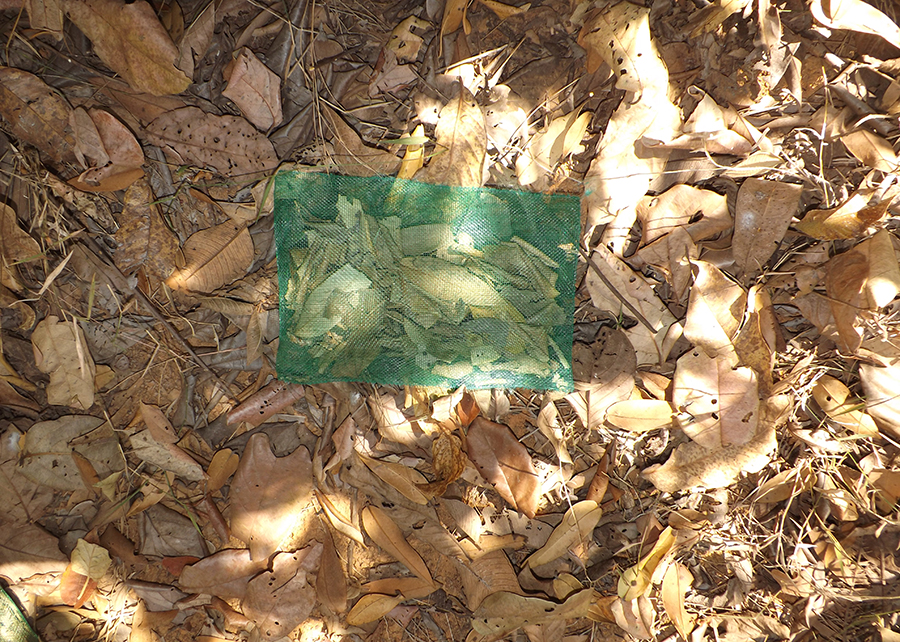
Research may contribute to environmental control and conservation initiatives, as restoration of degraded lands and control of organic matter loss in soils
An unprecedented study developed by researchers from Embrapa Cerrados, the University of Brasília (UnB) and the Federal Institute of Brasília (IFB) shows that the decomposition process of litter – a layer made of dead plant material and organic matter that covers the soil – has a direct correlation with the diversity of the local flora and with the synergism of factors, as the action of decomposers, which occurs mainly during the rainy season. The long-term research was carried out in an area of native forest in the Cerrado biome and can contribute to environment control and conservation initiatives, such as rehabilitation of degraded lands and control of soil organic matter losses..
Litter has an important role regarding the balance and the dynamics of the ecosystems, especially in regions like Cerrado, where most soils present low natural fertility. Consequently, its decomposition helps to maintain physical, chemical, and biological properties of the soil, besides being relevant to the ecological maintenance of diverse functions and forest systems.
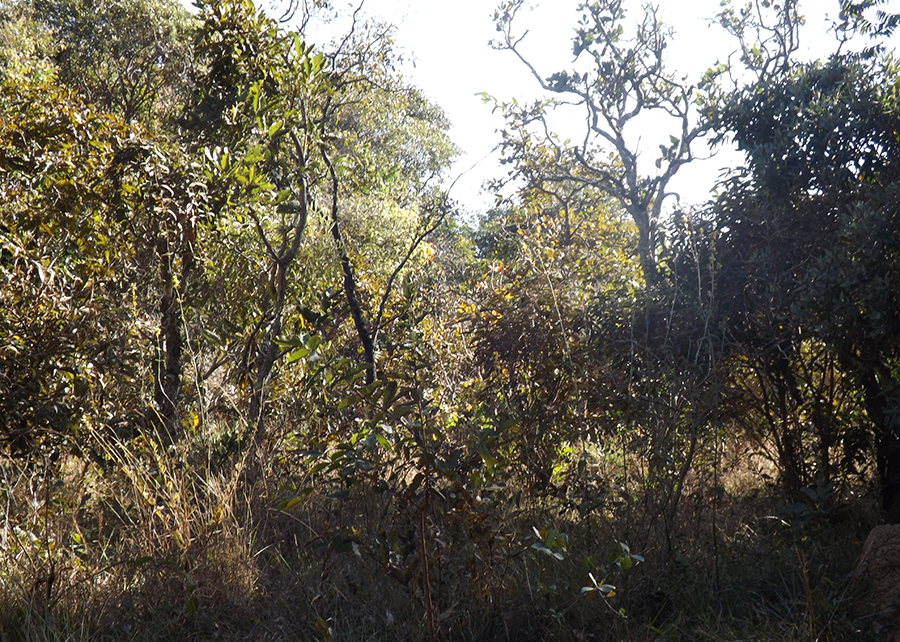 In the study, the litter decomposition in a savanic forest (Cerradão, on the right) was analyzed in accordance with the local floristic composition and seasonality, which is the alternance of dry and rainy seasons during the year, considering the Cerrado biome has two well-defined seasons: a rainy one (October to April) and a dry one (May to September). The work is described in the paper How long does it take to decompose all litter in Brazilian savanna forest?,whose main authors are Fabiana Ribeiro, from UnB, and Alexsandra Oliveira, from Embrapa Cerrados. The article is part of the doctorate theses of Ribeiro, whose co-advisor was Oliveira.
In the study, the litter decomposition in a savanic forest (Cerradão, on the right) was analyzed in accordance with the local floristic composition and seasonality, which is the alternance of dry and rainy seasons during the year, considering the Cerrado biome has two well-defined seasons: a rainy one (October to April) and a dry one (May to September). The work is described in the paper How long does it take to decompose all litter in Brazilian savanna forest?,whose main authors are Fabiana Ribeiro, from UnB, and Alexsandra Oliveira, from Embrapa Cerrados. The article is part of the doctorate theses of Ribeiro, whose co-advisor was Oliveira.
One of the paper's new findings is data on the total litter decomposition in a Cerrado area. Until the moment, scientific texts on the process in the biome had presented a short-term analysis, taking into consideration only half-life data, in other words, the quantity of days necessary to 50% of the organic matter to disappear, being the total decomposition time estimated by mathematical models. “We followed the litter decomposition until it was over, which represented 2,070 days of observation”, Ribeiro explains.
Picture above by: Fabiana Ribeiro
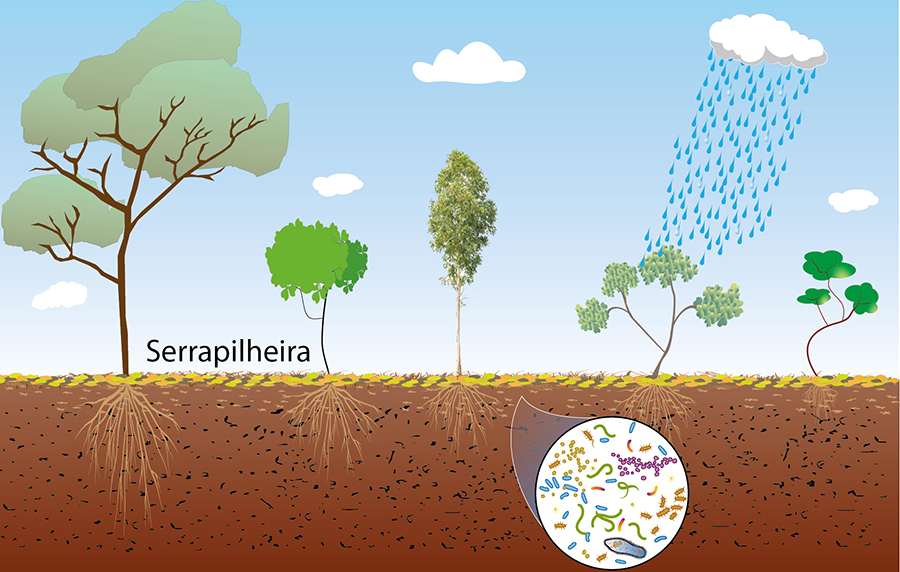
Art by: Wellington Cavalcanti (litter and soil microorganisms)
Research evaluated litter decomposition for almost 6 years
The research was carried out in a Cerradão area of 4 ha located in Quebrada dos Neres, rural area of Paranoá, DF, Brazil, where there have not been fires since 1996. Between August 2014 and May 2020, the researchers followed the decomposition of 240 litter samples of 20 g in nylon bags (litter bags) randomly distributed in the area. Every 3 months, ten litter bags were collected.
The litter half-life observed in the location was of 360 days, period in which decomposition was faster. After 180 days, losses were significative, being possible to observe great part of the inner structure of the leaves, which were fragmented on day 360. According to the literature, the most intense decomposition during the first months is due to its fragmentation by physical agents, by the soil fauna, and by the release of soluble compounds, such as sugars, starches, and proteins, which are fast consumed by decomposers. After this period, decomposition gets slower due to the higher percentage of more resistant structures, called recalcitrants, as lignin (molecule associated with rigidity, impermeability, and mechanical resistance to microbiological attacks on plant tissues) and cellulose, present in leaf and branch structures.
The decomposition of 75% of the sample material occurred between 720 and 810 days. In 1,710 days, only the structure of the ribs and the thin branches was observed mixed to the soil. The amount of biomass was constant between the days 900 and 1,980, reaching zero, 90 days after the last collection day (day 2,070). See the picture below.
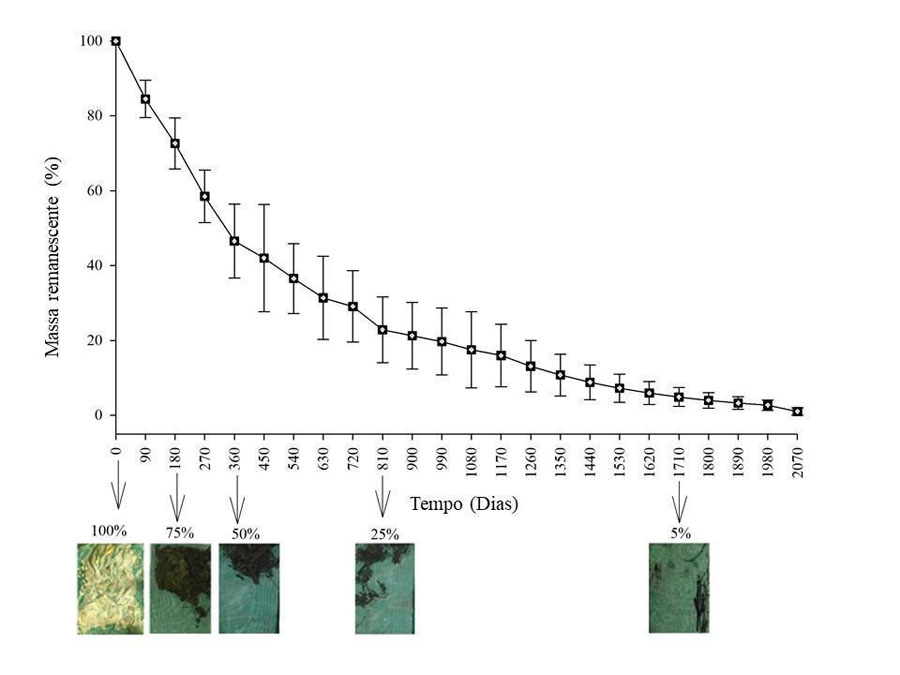
Massa principal remanescente (g) ao longo de 2.070 dias em área de Cerradão no Distrito Federal, Brasil.
As the study allowed for measuring the time required for all plants to be totally decomposed in the samples, different mathematical models used in scientific literature to estimate litter decomposition could be tested. Olson's model, which considers the time and the loss rate in relation to the initial mass, was the most appropriate model to estimate the velocity of the litter decomposition in the studied Cerradão area, because it presented the lowest underestimation of the process..
“After the tests, we reached a simple model that is closer to the reality”, comments Ribeiro. According to the UnB professor, the study, when testing models and suggesting what is best to Cerrado conditions, also contributes to diminish errors in overestimation or underestimation of litter decomposition estimative in the biome.
What influences litter decomposition? The rate of litter decomposition is influenced by diverse factors, such as nutrient concentration, lignin content, fauna action, among other agents that fragment vegetal matter, as well as climate, temperature, and precipitation. In Cerradão areas, as the one studied, litter is composed basically of leaves, which represent up to 70% of the material in different phytophysiognomies of Cerrado biome. According the Embrapa Cerrados researcher, similar studies suggest that Cerrado plants have developed conservative and efficient mechanisms to minimize nutrient loss during its decomposition, resulting in litter production with high rates of carbon/nitrogen (C:N) and carbon/phosphorus (C:P), which may cause low decomposition. She says Cerrado is an ecosystem with a low amount of nitrogen, in which 15% to 37% are reabsorbed before the leaves fall, and inorganic nitrogen is available by the mineralization of organic matter. “Thus, what is more palatable for decomposers diminishes over time, and we cannot believe that there is an increase in the amount of nitrogen and phosphorus. The concentration of these nutrients may have increased because of the characteristics of the litter, resulting in lower palatability, or, even, its form can be immobilized, which means that it is not available to decomposition”, she explains, adding that materials with high contents of soluble and simple substances are decomposed faster and easier than those with high contents of lignin. |
Influence of the rain
In Brazilian Cerrado, high temperature conditions and high water retentions contribute to litter decomposition at the beginning of the rainy season, with higher rates occurring when the rain starts falling. “It acts like a ‘bonus’ to decomposition and mineralization to happen, favored by climatic conditions”, Oliveira affirms.
During the six rainy seasons observed along the 5 years and 9 months of the study, it was verified, as predicted by scientific literature, the intense litter decomposition, which shows direct relation between this process and the precipitation rate.
According to the researchers, it occurs because litter decomposition is directly proportional to its palatability to decomposers. However, in dry seasons, when there is less water, the palatability is lower, consequently, litter decomposition gets slower.
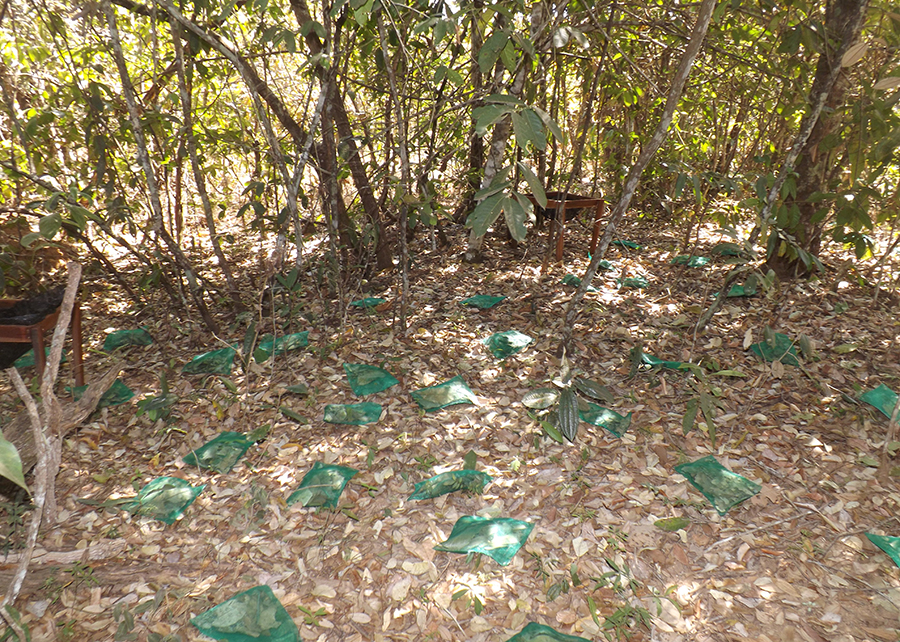 Flora diversity and litter decomposition dynamics Flora diversity and litter decomposition dynamics
Besides water availability, structural characteristics of litter help explaining the decomposition dynamics carried out by soil fauna. The size of the leaves, for instance, influences decomposition, since wider areas available to microorganism colonization make it more palatable to shredders, such as leafcutter ants. Therefore, an inventory of the floristic composition of the studied area was carried out with ten samples randomly distributed in the location, covering 1 ha. In the area, 83 species and 41 botanical families were found and classified in accordance with the density (number of individuals per hectare) and dominance (percentage of the area occupied by a species), among other factors. The Melastomataceae family presented more species, with 520 individuals. The species Miconia pohliana was the most dominant. The 20 most dominant species represented 84% of the ones presented in the samples. “If we know the existing species, we can verify how attractive the most present ones are to the local microorganisms”, says the UnB researcher, adding that the information of the study also represents other Cerrado areas. “The variety and diversity of forest species, the quantity, and the litter diversity, together with other biotic and abiotic factors, directly influence the litter decomposition, since these factors are linked to the process of modulation of the characteristics of microenvironments and decomposers responsible for the nutrient cycling through the litter”, concludes Ribeiro. Photo: Fabiana Ribeiro |
Results support projects of environmental conservation, recuperation, and control
As it is a non-destructive monitoring method to evaluate forest quality, the study of the litter decomposition dynamic produced relevant results for the elaboration of conservation and environment control projects.
The UnB researcher explains that, in association with other ecological data, it is possible to evaluate the behavior of the forest concerning biotic stresses, as the action of decomposers, and abiotic, as temperature and humidity. “In case the forest is substituted by a crop, it is possible to estimate the natural nutrient loss. According to the soil management, we can control the organic matter loss of the soil surface”, she exemplifies.
Additionally, knowing information on the species of a specific forest of a Cerrado area and on litter decomposition allows selecting the most attractive plant species to decomposers. “These plant species can be chosen at the planting moment according to the interest, considering the average efficient cycling estimative of the litter nutrients”, says the researcher, highlighting that this is an important initiative to projects on restoration of degraded lands.
“In this context, associated knowledge of the litter cycling time may contribute to resilience of the ecosystem [Cerrado] studies. Results like the ones we found can help generating and guiding public policies on climate resilience, which has to do with sustainability”, the Embrapa researcher concludes.
The authors of the study are Fabiana Piontekowski Ribeiro, Alexsandra Duarte de Oliveira, Angela Pereira Bussinguer, Maísa Isabela Rodrigues, Mikaela Soares Silva Cardoso, Ilvan Medeiros Lustosa Junior, Marco Bruno Xavier Valadão and Alcides Gatto.
Breno Lobato
Embrapa Cerrados
Translation: Ana Maranhão
Superintendency of Communications
Further information on the topic
Citizen Attention Service (SAC)
www.embrapa.br/contact-us/sac/

 In the study, the litter decomposition in a savanic forest (Cerradão, on the right) was analyzed in accordance with the local floristic composition and seasonality, which is the alternance of dry and rainy seasons during the year, considering the Cerrado biome has two well-defined seasons: a rainy one (October to April) and a dry one (May to September). The work is described in the paper How long does it take to decompose all litter in Brazilian savanna forest?,whose main authors are Fabiana Ribeiro, from UnB, and Alexsandra Oliveira, from Embrapa Cerrados. The article is part of the doctorate theses of Ribeiro, whose co-advisor was Oliveira.
In the study, the litter decomposition in a savanic forest (Cerradão, on the right) was analyzed in accordance with the local floristic composition and seasonality, which is the alternance of dry and rainy seasons during the year, considering the Cerrado biome has two well-defined seasons: a rainy one (October to April) and a dry one (May to September). The work is described in the paper How long does it take to decompose all litter in Brazilian savanna forest?,whose main authors are Fabiana Ribeiro, from UnB, and Alexsandra Oliveira, from Embrapa Cerrados. The article is part of the doctorate theses of Ribeiro, whose co-advisor was Oliveira.


 Flora diversity and litter decomposition dynamics
Flora diversity and litter decomposition dynamics